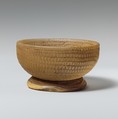Glass network mosaic bowl with base ring
Colorless with opaque yellow.
Vertical rim with ground, inward-sloping edge; convex curving side tapering downwards to slightly convex bottom; outsplayed base ring with thick rounded edge, applied as a coil with join down one side.
Network mosaic pattern formed from lengths of three canes laid side by side and wound round in a spiral to form body, ending on the bottom; each cane wound spirally with two parallel yellow threads; another cane also wound spirally with a double yellow thread is attached as rim; the base ring is streaked with yellow threads.
Intact, but with a few internal cracks; some pinprick and a few larger bubbles; dulling, pitting, and faint iridescence.
Similar glass bowls have been recovered from the Antikythera shipwreck, located south of the Peloponnese. This first underwater excavation in Mediterranean waters was undertaken with the assistance of sponge divers in 1900. The ship is thought to have been heading west when it sank sometime in the second quarter of the first century B.C. with a large cargo of terracotta amphorae, glass vessels, and large-scale sculptures of bronze and marble.
Due to rights restrictions, this image cannot be enlarged, viewed at full screen, or downloaded.
This artwork is meant to be viewed from right to left. Scroll left to view more.




